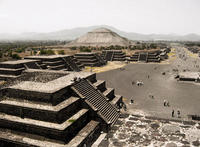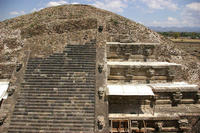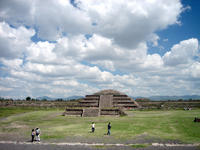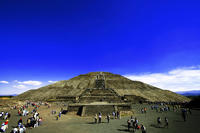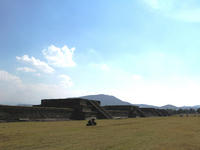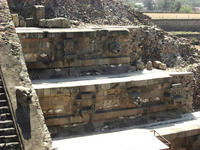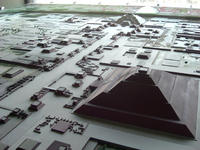You are in: North America -> Mexico -> Pre-Hispanic City of... , and traditional search or Image Gallery will yield results of this site only
Pre-Hispanic City of Teotihuacan
| Site number: | 414 |
|
| Type of site: | Cultural | |
| Date: | 1-7 cent. AD | |
| Date of Inscription: | 1987 | |
| Location: | North America, Mexico, Municipalities of Teotihuacan De Arista and San Martin De Las | |
Up to 75 images are shown here. Click on each for more details or on Image Gallery for more images.
| Description: | Found roughly 50 km north-east of Mexico City is the holy city of Teotihuacan ('the place where the gods were created'), which was built between the 1st and 7th centuries A.D. It is distinguished by the immense size of its monuments; among them are the Temple of Quetzalcoatl and the Pyramids of the Sun and the Moon, arranged on geometric and symbolic notions. As one of Mesoamerica’s most powerful cultural centers, Teotihuacan had a cultural and artistic influence over the region and even beyond it. --WHMNet paraphrase from the description at WHC Site, where additional information is available. | |
| Teotihuacán [teotiwa'kan] was, at its height in the first half of the 1st millennium CE, the largest pre-Columbian city in the Americas. The civilization and cultural complex associated with the site is also referred to as Teotihuacán. Its influence spread throughout Mesoamerica; evidence of Teotihuacano presence, if not outright political and economic control, can be seen at numerous sites in Veracruz and the Maya region. The city was located in what is now the San Juan Teotihuacán municipality in the State of México, Mexico, approximately 40 km (24.8 mi) northeast of Mexico City. It covers a total surface area of 83 km² and was made a UNESCO World Heritage Site in 1987. --Wikipedia. Text is available under the Creative Commons Attribution-ShareAlike License. | ||
| Source: | http://whc.unesco.org/en/list/414 | |
| Source2: | http://whc.unesco.org/en/list/414/video | |
| Reference: | 1. UNESCO World Heritage Center, Site Page. | |



